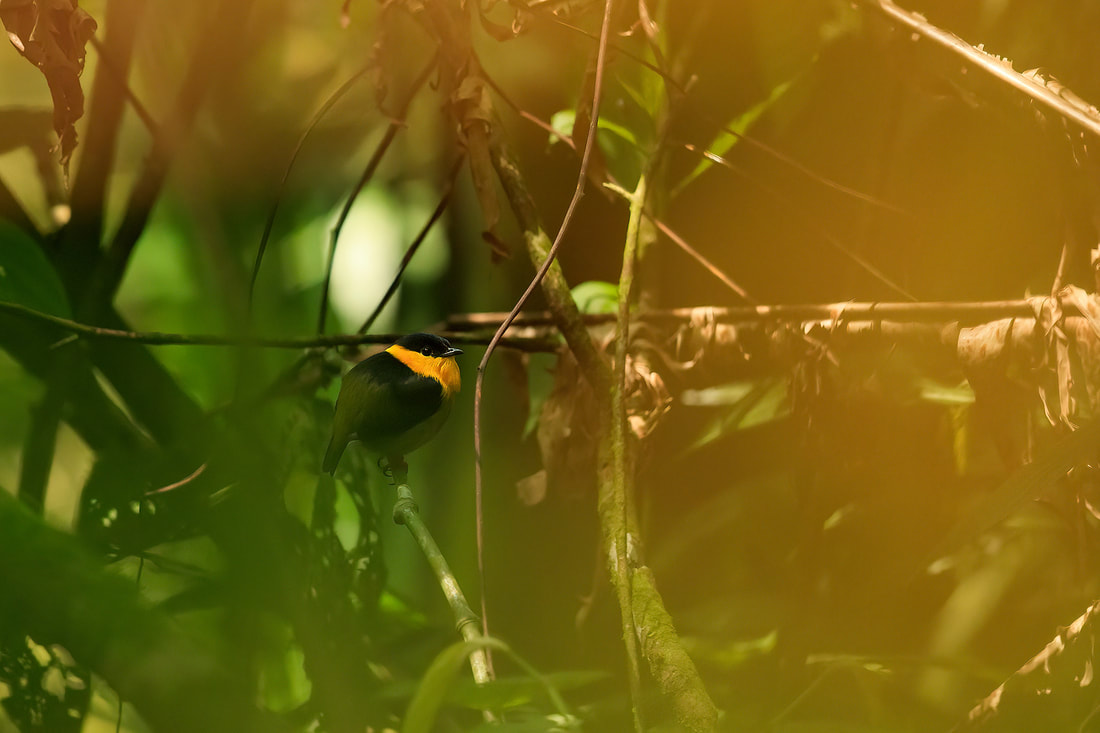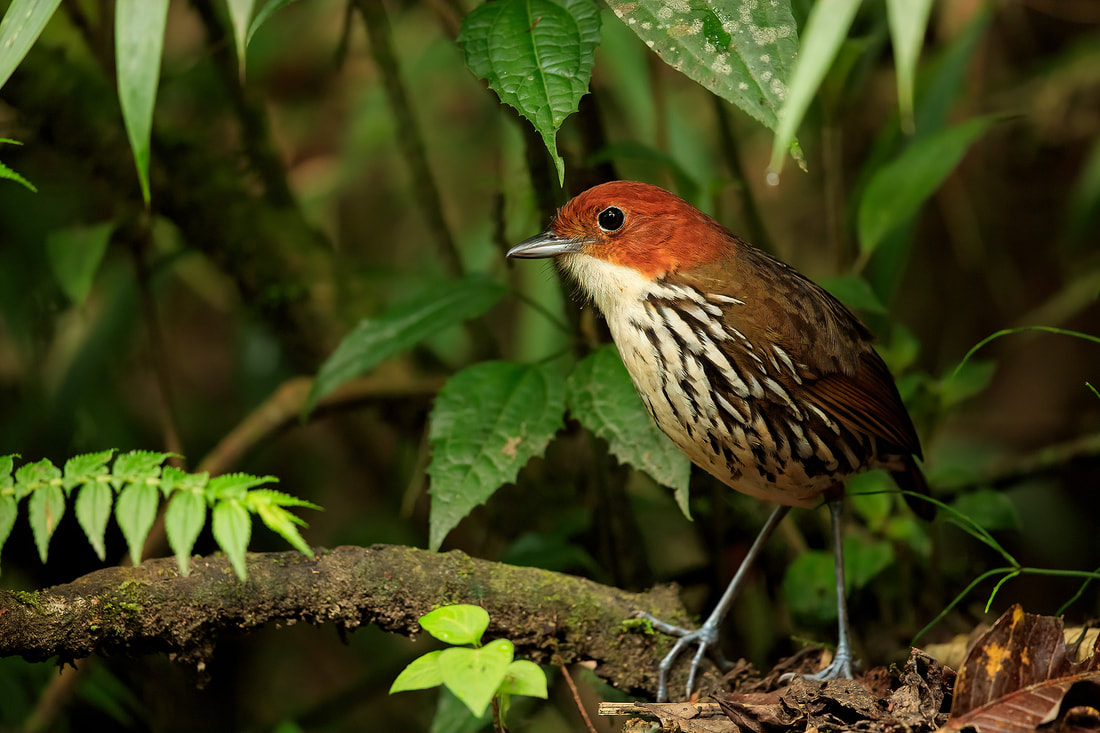|
I hope you have been enjoying this series from the trip I led to Colombia for Wildlife Worldwide? For the third instalment I am taking you higher in the Central Andes in search of some real specialities. We left Manizales and started our climb ever higher up to Nevado del Ruiz - a towering volcano home to a variety on habitats and countless species. Our first stop was the charming hillside property of Hacienda el Bosque. This working cattle farm has committed to protecting its high altitude forest and is actively planting corridors to help wildlife flourish on the property. It is little wonder that the property is a haven for numerous rarely seen species including the flammulated tree-hunter, grey-breasted mountain toucan and hooded mountain tanager. First up though was the equatorial antpitta at a feeding station before we went in search of the spectacular array of hummingbirds. What an incredible start to our day at the hacienda. In my opinion it only got better as the real stars made their appearance a little later on ... It was time for the grey-breasted mountain toucans and hooded mountain tanagers to put on quite the performance. As I am sure you can see, the photography was exceptional thanks to our magnificent subjects. I was blown away by the photography opportunities and the birds were just stunning. From here, we headed further up the mountain in search of higher altitude species including an endemic hummingbird - the buffy helmetcrest. In fact we were also treated to incredible views of tawny antpitta, lacrimose and scarlet-bellied mountain tanagers and rainbow-bearded thornbill. We were incredibly spoilt, but it is important to highlight the amount of time that has to be put in to get the images you are after. I hope you have enjoyed looking through these images and discovering the wonderful birdlife that calls Colombia home. I really can't recommend visiting the Central Andes enough - it is a birder's and photographer's paradise.
Find out more about the trip on the Wildlife Worldwide website and book your place under the expect guidance of Ben Sutcliffe.
4 Comments
It has been another action-packed year for me. With the travel sector back in business, I was busier than ever (making up for lost time) leading tours left, right and centre. With such a busy year, I haven't really had time to focus on my own projects, but I was able to capture a few wonderful moments when out in the field with clients. So with that in mind, I thought I would share my 'Top 5' images from the year of 2022. I should add that these are in chronological order and just a small selection of some of personal favourites. In case you haven't yet realised, I really love taking portraits of wildlife. I would love to know which is your favourite. The wonderful thing about photography is that it is completely subjective. My decision making behind this selection is probably biased, as my memories of each moment are likely to change my perception of the image itself. Anyway, I do hope you enjoy them.
2023 promises to be another busy year and I will do my utmost to keep this blog up to date. In the mean time, I have two more posts to come from my Colombia tour, another focusing on South Luangwa in Zambia and a final one from Australia. Happy reading! I know. It has been a while since I last posted about the wonderful bird photography tour I led to Colombia for Wildlife Worldwide. I left you after photographing the absolutely beautiful toucan barbets of the western Andes. Today I am going to whisk you further north towards the city of Manizales and share with you a kaleidoscope of new colours and forms. Of course, with this being a bird photography tour, if you aren't a fancier of our avian friends, I suggest you wait for my upcoming blog on Zambia's South Luangwa National Park. So to start you off easy, here are a couple of images taken from the Tinamou private reserve. The first was the diminutive golden-collared manakin. This tiny bird was incredibly challenging to photograph and my entire group had to work extremely hard to capture a 'record' shot - it was definitely about trying to capture it in its thick rainforest home. The second bird from here is the striking bar-crested antshrike. After a couple of days exploring the trails and gardens of Tinamou, we headed across Manizales to the protected area of Rio Blanco Reserve. This cloudforest habitats has been set aside as a water catchment area for city below and in turn provides a refuge for numerous sought-after bird species. It is particularly well known for several species of antpitta - the most photogenic of these was undoubtedly the chestnut-crowned antpitta which was a perfect poser. The whole group were treated to some exceptional photography opportunities from only yards away. After a morning with the antpittas we spent a prolonged period around the garden feeders, which attracted numerous hummingbirds such as buff-tailed coronet (the most common visitor) and the star bird which was the long-tailed sylph, alongside a number of other passerines. As we descended down the mountain back towards the city of Manizales, we came across our first roadside hawk of the tour - it posed perfectly as everyone snapped away - providing some wonderful photography opportunities. Further down the steep road, we stopped at a small reservoir's dam and immediately saw the handsome white-capped dipper. Like the roadside hawk, it posed beautifully for a brief moment on the dam wall. As we neared the bottom of the steep-sided mountain and crossed the river, our guide Juan spotted a torrent duck. These birds are notoriously hard to approach and tricky to photograph, but we were in luck as the bird was preoccupied with chasing a pair of white-capped dippers. The male duck was just the perfect subject as it came back and forth, stopping atop of numerous rocks with the lush forest-clad banks behind. As I am sure you are starting to appreciate, Colombia is a birder's dream and as a wildlife photographer I think it is equally a rewarding. My group all took such a wide gamut of images, capturing numerous species in flight, feeding and just in their habitat. What more can you ask for?
I will try and bring you the next instalment within the next couple of weeks. In the meantime, you can read my tour report from the trip and find out more information on the Wildlife Worldwide website. |
AuthorBret Charman Archives
July 2024
Categories
All
|

























